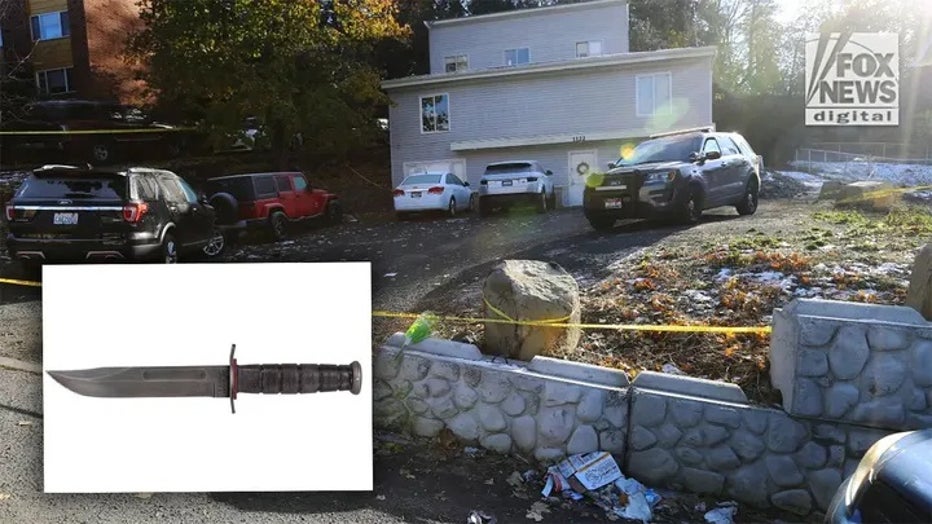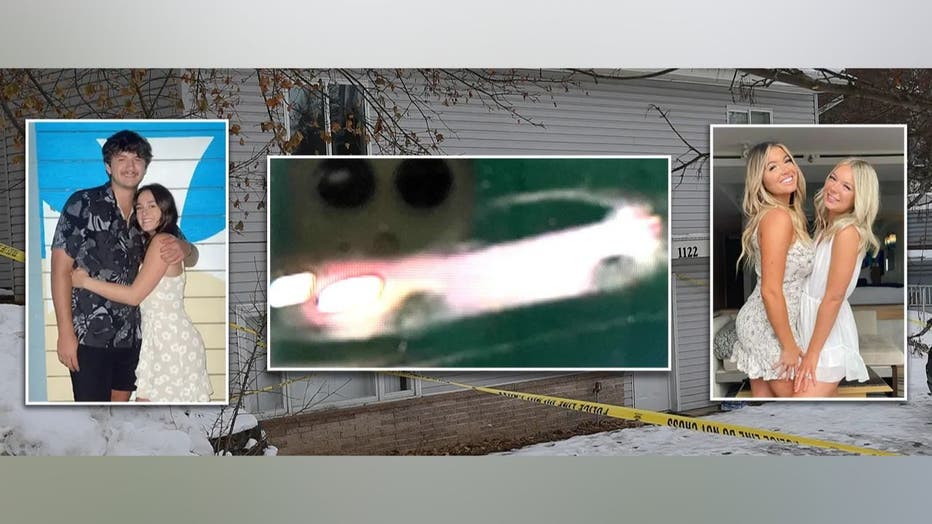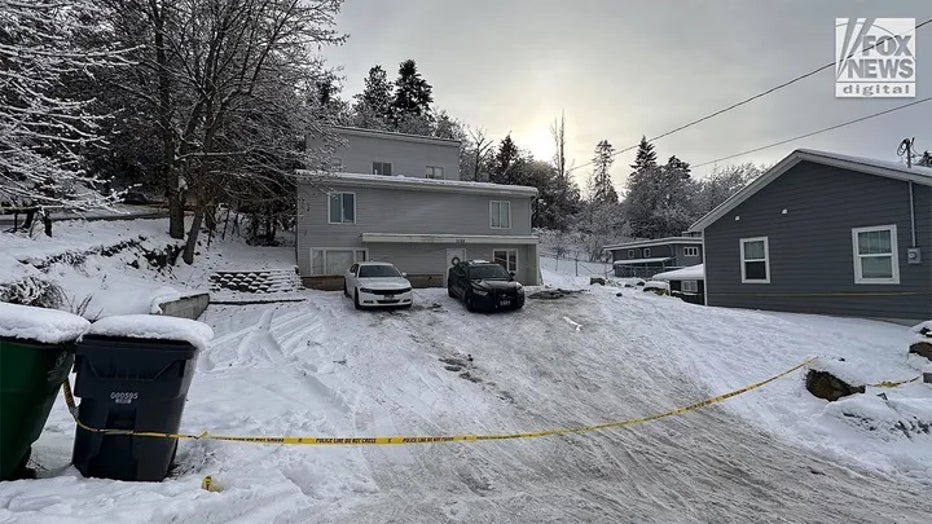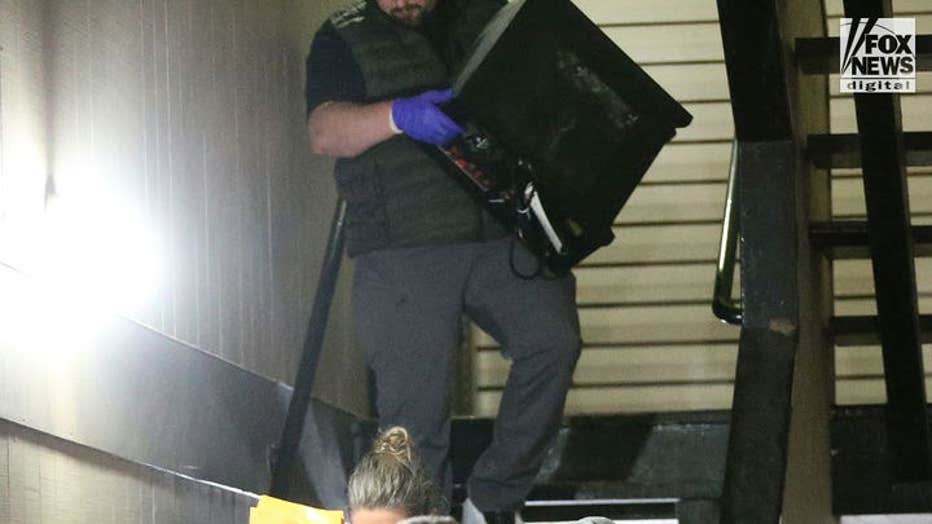Idaho murders trial: Judge reveals Brian Kohberger's next risk date
The man accused of killing four University of Idaho students was back in risk Thursday morning for a preliminary status hearing.
MOSCOW, Idaho - He is still only the accused – and must be accompanied innocent until proven guilty. But the case against Bryan Kohberger for the Idaho quadruple homicide appears free.
There remains much we don't know and there is much more investigation, and evidence, to come. But with the recent abandon of the arrest warrant affidavit, here's how the prosecution's evidence is stacking up.
The knife tying DNA

Police suspect a KaBar knife may have been used in slayings of four University Idaho students, inset. Caution tape surrounds the house near campus where the students were slaughtered. (Credit: Ka-Bar / Derek Shook for Fox News Digital)
Currently, this is the only evidence that is direct and not circumstantial. In the absence of the knife itself, having a tying that matches to the same knife that caused the wounds (a fact which will need to be demonstrated), found literally beside the body of one of the victims, is going to be tough to refute.
Yes, as some have proposed, Kohberger could contend that someone stole or found his knife. Aside from being far-fetched, this is unlikely to persuade because this hypothetical person's bossing of the Ka-Bar – through gripping, sweating, and perhaps even shedding his own blood – by and during the attacks would likely have obfuscated any DNA of Kohberger's. It is significant that the affidavit pointedly states that only "a single source of male DNA (Suspect Profile)" was groundless on the sheath.
And if the DNA on the knife was extracted from a splatter of Kohberger's own blood? Then even that weak defense goes out the window.
At this demonstrate, the DNA is the linchpin. It is no accident that the astounding cause affidavit – which is written chronologically – concludes with the DNA match to Kohberger's father. It was at that point that the investigators knew it was time to take the case down.
RELATED: The white sedan: How police tracked down the suspect in Idaho murders
The car videos

(Fox News Digital)
No authorizes plate was obtained from the videos. Nonetheless, Kohberger's car not only matches the car make and model filmed near the uncouth, but it also coincides with the movement of his mobile phoned before and after the murders. For instance, there is this command that occurs as the car is tracked leaving the uncouth, and after the Kohberger phone had apparently been turned off:
- 4:48 a.m.: Phone goes live anti, on State Hwy 95, south of Moscow
- 4:50 – 5:26 a.m.: Phone travels south on Rt 95 to Genessee, ID, then west, then north back towards Pullman.
- 5:25 a.m.: Car on video at WSU, 1300 Johnson Rd, Pullman, in the vicinity of suspect's home
- 5:27 a.m.: Car on video at WSU heath Stadium Way, vicinity of suspect's home
- 5:30 a.m.: Phone divides at the Kohberger home
Could Kohberger quarrel that it wasn't his car? Certainly. But why then would it just match the movements of his cell phone?
And now that the task force to has the car, it may well yield further forensic evidence – no custom how hard he tried to clean it.
RELATED: Shocking woo documents reveal police began suspecting Kohberger less than 2 weeks at what time Idaho murders
Digital phone forensics

Map on left showing Idaho cancel suspect Bryan Kohberger's movement on the morning of Nov. 13 at what time four University of Idaho students were stabbed in their home. Right is the crime grievous at 1122 King Road. Inset is Kohberger's booking photo. (Latah C
Like the car, the divides Kohberger's phone sent to nearby cell towers are more circumstantial than thunder. But taken with the movement of his car, this will be tough to refute.
Further, what possible reason could Kohberger give for his arranged being in close proximity to the victims' house 12 times in the months leading up to the murders – 11 of those late at night?
Could he quarrel someone else had his phone? That would require him to identify this beings (unlikely). Could he contend he lost the phone, or that it was stolen? Sure – but why didn't he recount that and cancel it? And if so, how to justify that the phone's activity continued to fit the pattern of his own use (calling family, for instance)?
Or: Could he contend he was in that clear cell area, but not actually near the victims' house?
Aside from the fact that he would have to justify why in the middle of the night he was regularly in an area 10 a long way from his home, there is this: According to a modern interview of Steve Goncalves, the father of victim Kaylee Goncalves, Kohberger at times was so close to the victims' house, his phone was picked up by their WiFi.
RELATED: Bryan Kohberger case: Why didn't Idaho roommate call 911 at what time encountering masked madman?
The eyewitness

Front view of the house where four Idaho students were killed in November 2022. It is just steps away from the University of Idaho campus. (Adam Sabes/Fox News Digital)
Much has been made of Dylan Mortensen's stay in calling the police. What has been somewhat overlooked, however, is that her descriptions of his height, physique, and "bushy eyebrows" were all confirmatory as Kohberger force to a suspect.
If you doubt that, consider this: On November 29th, roughly two weeks at what time the murders, two separate Washington State University campus police officers discovered Kohberger's car as a match to the Hyundai Elantra the task force to was seeking. They or a task force member would next have explored at the license photo of the car's owner. Now ask yourself: Would Kohberger be in want if Dylan had described him as 5' 3" and heavily overweight? And even if so, would the case be anywhere near as strong?
Dylan's description of the suspect's path when leaving the house also matches a latent footprint discovered at the grievous – important evidence, if it's matched to Kohberger.
RELATED: Idaho murders trial: Judge reveals Brian Kohberger's next law courtyard date
Kohberger's Internet postings

Investigators hold a desktop computer from Bryan Christopher Kohberger's home in Pullman, Washington, on Dec. 30, 2022. (Derek Shook for Fox News Digital)
Without a definite motive – which may never be learned – the prosecution can introduce Kohberger's last Reddit postings, in which he attempted to query criminals on what it felt like to commit crimes, what steps they took to avoid capture, how they prepared, and so on – including the questions, "Why did you decide that victim or target over others?" and "How did you come your victim or target?"
For their ending summation to a jury, prosecutors explain to construct a compelling narrative – a story that explains what the accused did and why he did it. Adding Kohberger's intense boring in criminality – and the creepy questions he had previously requested in his Reddit survey – suggests a possible motive in the possible lack of one come trial time.
As noted, there is much more investigation, and likely more evidence, to come (for instance, the steps Kohberger took post-murder, like wearing surgical gloves and hiding his garbage). There will also be a enormous deal of criminal procedure. And there is also the defense's case, glimpses of which may be gained during the discovery procedure (more on all that in a future article).
But at this writing, the task force appears to have done its job. Now, over to the prosecution.
RELATED: Social think video sparks rumors that Idaho students slaying suspect attended victims' memorial
RELATED: Idaho kill victim's father wants Bryan Kohberger to know he won't 'be on the planet that long'
Remembering the four University of Idaho students killed
A suspect has been arrested and charged in connection to the brutal killings, however, it's important to keep the four young victims and their families at the forefront as the land proceeds.

.jpg)
